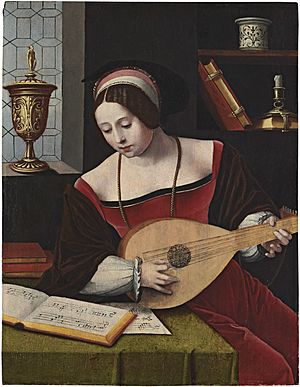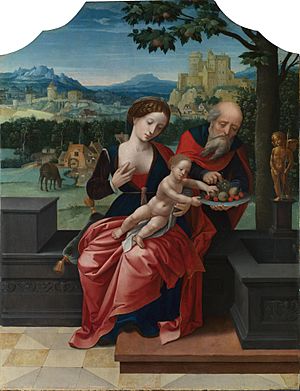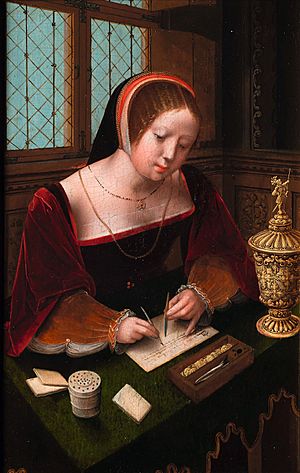Master of the Female Half-Lengths facts for kids
The Master of the Female Half-Lengths is a special name given to an artist, or more likely a group of artists, who worked in the Low Countries (which includes modern-day Belgium and the Netherlands) in the early 1500s. We don't know their real name, so "Master of the Female Half-Lengths" is a nickname given to them in the 1800s. This name helps us talk about the many paintings they created. These artists were known for painting women, often showing only the top half of their bodies. They also painted small religious scenes, mythological stories, landscapes, and portraits.
What Kind of Art Did They Make?
The paintings linked to the Master of the Female Half-Lengths seem to have come from a large art workshop. This workshop was very good at creating small paintings of noble young women. These women were usually shown from the waist up, doing things like reading, writing, or playing musical instruments.
All the women in these paintings often have a similar look: a heart-shaped face and a kind, gentle expression. Their faces show a sweet and graceful feeling. The artist wanted to show the high artistic and moral values of the Northern Renaissance, a time when art and learning were very important. The figures are usually placed inside a room with wood panels or against a plain background. Some of the women are shown with a small jar, which is a symbol often linked to Mary Magdalene.
The Master also painted a few pictures about old myths and copied popular religious scenes. These included paintings of the Crucifixion (Jesus on the cross), the Deposition (Jesus being taken down from the cross), and the Virgin of Sorrows (Mary feeling sad). These religious paintings often show large, detailed landscapes with small figures in them.
Because the workshop repeated many of the same ideas and compositions, it suggests they made art mainly to sell in open markets and to send to other countries. They didn't seem to paint much for specific people or places. A few portrait paintings have also been linked to this mysterious artist.
Who Was This Artist?
We don't know for sure who the Master of the Female Half-Lengths was, or exactly where and when they worked. Art experts have suggested different cities like Antwerp, Bruges, Ghent, Mechelen, or even the French court as possible locations for their workshop. Estimates for when they were active range from the early to the late 1500s. However, most experts believe they were active in the early 16th century.
One art historian, Otto Benesch, thought the Master might be a Bruges artist named Jan or Hans Vereycke. But not all art historians agree with this idea.
Some experts believe the artist must have worked in Antwerp or Mechelen around the 1520s and 1530s. This is because the landscapes in their paintings are similar to those by Joachim Patinir, and the women look a bit like those painted by Bernard van Orley. There are also some similarities between the Master's work and that of other artists from Bruges, like Ambrosius Benson and Adriaen Isenbrant.
Even though the figures look like those by Isenbrant, who worked in Bruges, it's more likely the Master was active in Antwerp. This is because Antwerp was a major center for art export in Flanders at that time. Also, their landscapes were inspired by Joachim Patinir, who was active in Antwerp. Experts have also noticed similarities between the Master's figures and those of another unknown painter in Antwerp, called the Master with the Parrot.
See also
 In Spanish: Maestro de las medias figuras femeninas para niños
In Spanish: Maestro de las medias figuras femeninas para niños




